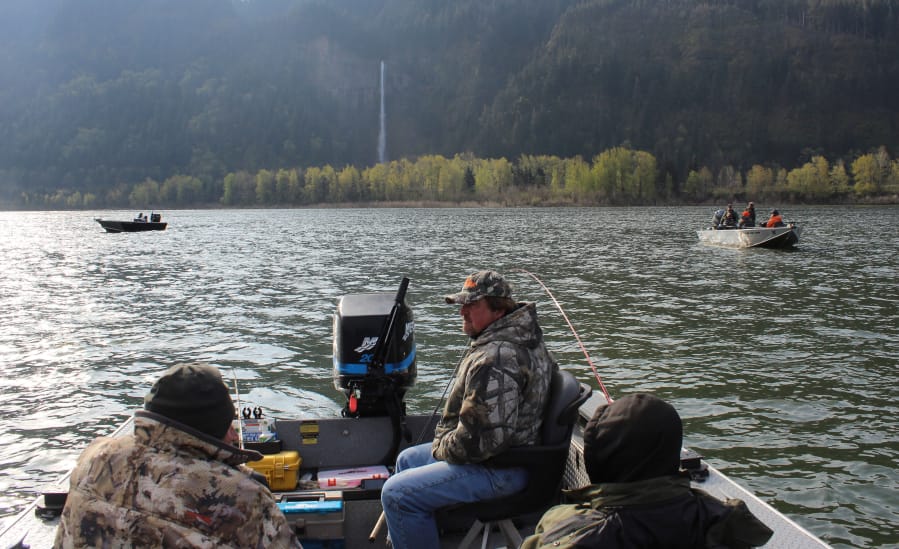The Northwest Sportfishing Industry Association (NSIA) held its annual run forecast meeting last Tuesday at the Oregon Department of Fish and Wildlife’s Evelyn Street office in Clackamas.
Staff from both the ODFW and the Washington Department of Fish and Wildlife gave a presentation to fishing guides, representatives of the fishing tackle industry, members of the press, and members of the NSIA, concerning the first projections of 2020 for Columbia River fish runs.
Overall the projections mirror those of 2019. There were a few bright spots, but for the most part runs are still struggling. The likely scenario is that anglers will see fishing seasons for spring Chinook that are similar to last years.
“We go through long term cycles up and down and where we are right now is, we are heading down,” said John North, the ODFW Columbia River fisheries manager,
Much of the meeting was spent discussing the prevailing poor ocean conditions, and how it affects the salmon and steelhead populations. Ocean indicators continue to paint a picture that is less than optimal for salmon survival.
A total of 135,800 spring Chinook adults are expected to return to the mouth of the Columbia River in 2020. Of those fish, 54,100 are headed to the lower Columbia.
The 2019 projection was for 157,500 total Columbia springer adults, but the actual return was 109,808. Only 36,7070 of those springers made it back to the lower Columbia, missing the 2019 projection of 58,200.
Last year the lower Columbia from Buoy 10 to the I-5 bridge was open seven days a week in January and February but was closed on March 1 to protect poor projected hatchery returns of spring Chinook headed to the Cowlitz and Lewis Rivers. The hatcheries on those streams barely made their brood stock goals in 2019.
The Columbia from Warrior Rock at the mouth of the Lewis to Bonneville Dam opened March 1 and ran through April 10. An additional six days were added later in the season.
In 2020, once again, the trouble spots are the Lewis and Cowlitz Rivers. With only 1,400 springers expected to return to the Cowlitz, and the same number projected for the Lewis, odds are the lower Columbia will remain closed again this year.
“Basically, everything we saw in 2019 we will see again this year,” said fishing guide Bill Monroe Junior of Bill Monroe Outdoors. “We can almost guarantee we will be fishing above Warrior Rock only.”
Monroe reported that the lower river closure concentrated anglers from Warrior Rock up to Davis Bar, and the crowding was intense.
“It was a nightmare,” he said.
The projection for the Kalama River is for 1,000 adults, which may constrain any fishery on the tributary.
Oregon’s Willamette River 2020 projection of 40,800 adults is a little higher than last year’s projection of 40,200, but the run under performed and came in at only about 28,000 in 2019. The river was kept open seven days a week with a two Chinook limit under permanent regulations.
The same season structure is expected for 2020.
Last year 99,300 springers were expected to cross the Bonneville Dam, but the actual return was 73,000. The projection for this year is 81,700.
The Wind River should see about 2,000 spring Chinook in 2020, compared with an actual return of 1,500 in 2019.
The 2019 Drano Lake run came in at 3,571 adults, well below the 5,600 that were forecast. 4,600 are expected this year.
Only 404 spring Chinook returned to the Klickitat River last year. The expectation for 2020 is 1,800 adults.
Oregon’s Sandy River will probably see a return of 5200, which is better than the actual 2019 return of 3,200. The Hood River could see a return of 2,300 springers.
Summer Chinook numbers will probably not be strong enough to allow a fishery in the lower Columbia River again this year, with 38,300 forecast to the Columbia. That would still be an improvement on the 34,000 return in 2019.
Sockeye numbers are one bright spot. The expected run of over 246,000 is well above the recent returns. However, low projected returns to the Snake River may constrain managers ability to open a lower Columbia retention fishery for sockeye.
Fall salmon run projections will be finalized early next year.
Discussions of fall fisheries at the meeting centered around the underperforming coho run of 2019. Staff from both states expressed concern about the fact that the big jack return of 2018, which should have been a sign of a very strong return in 2019, but that did not pan out.
The fact that there were so many jacks that did not survive to spawn means something happened to adult coho in the ocean. Managers can only speculate about the reason.
However, the fact that the forecast missed as badly as it did may be indicative of problems with the scientific models used to predict the runs as the climate continues to change and warm.
“Certainly, the ocean has turned a little bit (poor) again in 2019.” Said Tucker Jones, the ODFW manager of ocean salmon and Columbia River. “Climate change is going to make everything more variable and dynamic, so for sure it’s a real possibility.”
So, what does an angler do in tough times such as these?
Buzz Ramsey of Yakima Bait talked about his strategy in bad years.
“When the run is down its best to plan your trips around the peak times,” said Ramsey, “because what happens is, if you have a big run, the run starts earlier and lasts longer. With a lesser run the peak is usually about the same, but it doesn’t extend out as long.”
“Anglers that want to catch big, bright salmon need to be out there during the peak times,” he added.




